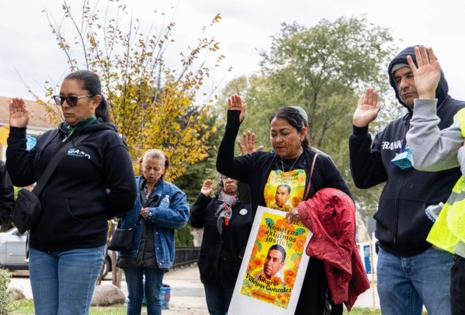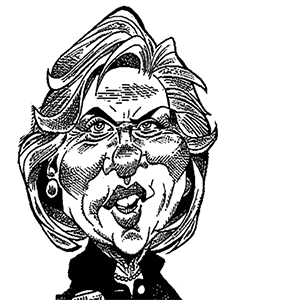Autopsy shows father of 2 fatally shot by ICE struck in neck, had cocaine in system
Published in News & Features
A father of two fatally shot by an immigration agent during a traffic stop in Franklin Park in September was struck in the left side of his neck before crashing the car into a semitruck, according to autopsy results obtained Monday by the Tribune.
When paramedics brought Silverio Villegas González to the hospital, doctors found “apparent drug paraphernalia” in his possession, and toxicological studies later showed he had low levels of cocaine in his blood at the time of his death, the autopsy results showed.
A relative of Villegas González, meanwhile, told the Tribune he did not use drugs and worried the information could be used to cast him in a misleading or negative light as the investigation into the shooting continues.
The details, released more than two months after the Sept. 12 shooting, are virtually the only investigative records made public in the controversial case, which came in the early days of the Trump administration’s immigration-enforcement push known as Operation Midway Blitz.
The investigation into the shooting was initially handled by the FBI, and notes from a Cook County medical examiner’s office investigator indicated he was told by an FBI agent at the scene that the agency “would be taking jurisdiction of the case.”
But sources later told the Tribune it was the U.S. Department of Homeland Security that was handling the follow-up investigation, including whether the officer was justified in opening fire.
A DHS spokesperson was not immediately available for comment Monday.
Villegas González, 38, had just dropped off his kids at day care and was on his way to work when agents with U.S. Immigration and Customs Enforcement pulled him over near the intersection of Grand Avenue and Elder Lane, a largely residential area also near an animal hospital, a nail shop and a high school.
In a statement released shortly after the shooting, DHS officials said Villegas González “refused to follow law enforcement commands and drove his car” at the agents, striking one and dragging him “a significant distance.”
“Fearing for his life, the officer discharged his firearm and struck the subject,” DHS said.
Both the agent and Villegas González were taken to nearby Loyola University Medical Center in Maywood, where Villegas González was pronounced dead.
DHS officials originally said the agent who was dragged was in critical condition. But body-worn camera footage released by Franklin Park police two weeks later showed the agent told police at the scene his injuries were “nothing major.”
The autopsy results, meanwhile, show Villegas González was struck in the left side of his neck by a bullet that traveled on a downward trajectory and wound up lodged in his lower-right chest, suggesting the gunfire came from someone above him on the driver’s side of the car.
He also suffered graze wounds to the pinky and ring fingers on his left hand, the report showed.
When Villegas González arrived at the hospital, he had $6 in his wallet, along with a LINK benefits card and his ID, the report showed. Emergency room personnel also found “apparent drug paraphernalia … on his person,” the report stated, without providing further details.
“It was unknown if the decedent had any history of illicit drug use or alcohol abuse,” the report said.
Toxicology tests showed Villegas González had relatively low amounts of cocaine and benzoylecgonine — a byproduct of the body breaking down the narcotic — in his blood at the time of his death, according to the 38-page report.
The official cause of death was multiple gunshot wounds and the manner of death was homicide, according to the pathologist’s report.
Asked about those findings Monday, Graciela Villegas, Silverio’s sister, told the Tribune her brother did not use drugs. At the time of his death, he was dealing with liver complications and taking medication, another reason he avoided alcohol and tobacco entirely, relatives said.
“He had overcome a very serious illness, and because of that he didn’t drink, he didn’t smoke, he didn’t use anything,” she said. “Maybe before he got sick things were different, but he had been clean for about a year and a half.”
She added that Villegas González was in the process of obtaining full custody of his children, a situation she says would have made him “extremely cautious” about his health and behavior.
“He would never risk using drugs knowing a caseworker could come by at any moment to check on the kids,” she said.
The killing sparked immediate protests around the Chicago area as citizens, politicians and advocates condemned the crackdown under the administration of President Donald Trump on immigrants in the U.S. without legal permission.
Villegas González, who was from Mexico and had been living in the U.S. for nearly 20 years, was buried in his hometown of Irimbo in central Mexico several weeks later.
The controversial shooting spurred calls for a vigorous and transparent investigation by figures including Gov. JB Pritzker and Mexican President Claudia Sheinbaum. And on Tuesday, Illinois Democrats led by U.S. Sen. Dick Durbin wrote to U.S. Secretary of Homeland Security Kristi Noem asking for transparency and urging her to end what they called “dangerous operations” in the Chicago area.
Neither of the ICE agents involved in the shooting were wearing body cameras, and no surveillance footage showing the agent allegedly being dragged or opening fire has publicly surfaced.
DHS officials said in a statement after the incident that the agent who shot Villegas had worked for ICE since 2021 and that this was his first time firing his weapon in a use of force incident.
Body-worn camera video since released by Franklin Park police showed its officers arrived at the scene to find a pair of agents hunched over Villegas González, who had been pulled out of his car and was limp on the side of the road.
“He tried to run us over,” one agent said.
When a Franklin Park police officer asked the agents if they were OK, one federal officer appeared to give a double thumbs-up in response. Both agents deemed the bloodied knee and cut-up hands on the officer apparently dragged to be “nothing major.”
The body-camera footage captures a conversation between Franklin Park police Director Michael Witz and Officer Thomas Ferris about whether Illinois State Police or Franklin Park would investigate the shooting.
“It’s their guys who shot,” Witz said. “You know what I’m saying?”
“Public Integrity?” Ferris asked.
“It’s their guys. It’s not our guys.”
____
©2025 Chicago Tribune. Visit at chicagotribune.com. Distributed by Tribune Content Agency, LLC.







Comments